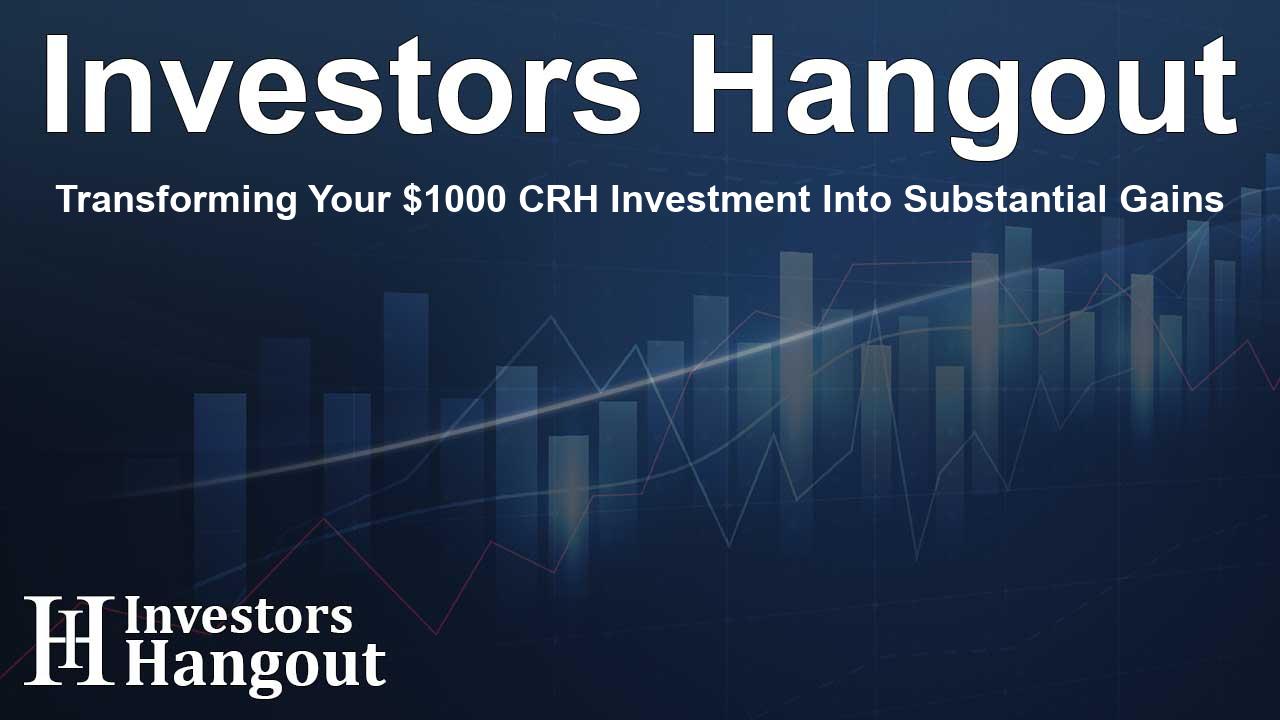Transforming Your $1000 CRH Investment Into Substantial Gains

Boosting Your Investment: The CRH Success Story
CRH PLC (NYSE: CRH), a prominent player in the construction materials sector, has showcased impressive growth over the past five years. With an annualized return of 25.26%, this stock has significantly outperformed the general market, increasing an initial investment of $1000 to a remarkable $3,083.47 today. Given its current market capitalization of $79.15 billion, CRH's strategic vision and operational excellence have driven this success.
The Impact of Compound Growth
Understanding Compounded Returns
When it comes to investing, the concept of compound growth is a powerful mechanism that can radically enhance the value of your money over time. CRH's impressive performance illustrates how an investment can flourish through the magic of compounding. By retaining profits reinvested back into the stock, your initial investment can multiply, as seen in the aforementioned return on CRH stock.
Investment Considerations: Why CRH Stands Out
Investors are often drawn to companies like CRH due to their robust financial health and growth potential. The company's diverse portfolio, which spans various materials essential for construction and infrastructure development, ensures a steady revenue stream. Additionally, CRH's commitment to sustainable practices has positioned it favorably in a market increasingly focused on eco-friendliness.
Market Conditions and CRH's Performance
As economies globally rebound and the demand for construction materials surges, CRH is well-placed to capitalize on these trends. The company's proactive investments in technology and capacity expansion further enhance its operational efficiency, enabling it to meet changing consumer demands effectively. These strategic moves have played a significant role in supporting the impressive return on investment over the years.
What the Future Holds for CRH
Looking ahead, CRH plans to further seize growth opportunities in key markets. Their focus on innovation and sustainability may attract even more investors, making them a staple in many investment portfolios. With industries revitalizing post-pandemic and governments prioritizing infrastructure investments, CRH's growth story is far from over.
Frequently Asked Questions
1. How much would a $1000 investment in CRH stock be worth today?
A $1000 investment in CRH stock five years ago would be worth approximately $3,083.47 today.
2. What factors contributed to CRH's strong performance?
Factors such as compound returns, a diverse portfolio, financial health, and strategic investments have driven CRH's strong performance.
3. Why is compound growth important for investors?
Compound growth allows investments to increase at an accelerating rate, significantly boosting the value of initial investments over time.
4. What is CRH's current market capitalization?
CRH currently holds a market capitalization of $79.15 billion.
5. What does the future look like for CRH?
CRH is poised for continued growth, focusing on innovation and sustainability while capitalizing on reviving market demand.
About The Author
Contact Ryan Hughes privately here. Or send an email with ATTN: Ryan Hughes as the subject to contact@investorshangout.com.
About Investors Hangout
Investors Hangout is a leading online stock forum for financial discussion and learning, offering a wide range of free tools and resources. It draws in traders of all levels, who exchange market knowledge, investigate trading tactics, and keep an eye on industry developments in real time. Featuring financial articles, stock message boards, quotes, charts, company profiles, and live news updates. Through cooperative learning and a wealth of informational resources, it helps users from novices creating their first portfolios to experts honing their techniques. Join Investors Hangout today: https://investorshangout.com/
The content of this article is based on factual, publicly available information and does not represent legal, financial, or investment advice. Investors Hangout does not offer financial advice, and the author is not a licensed financial advisor. Consult a qualified advisor before making any financial or investment decisions based on this article. This article should not be considered advice to purchase, sell, or hold any securities or other investments. If any of the material provided here is inaccurate, please contact us for corrections.
